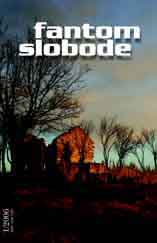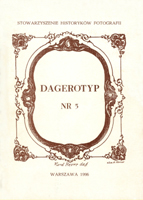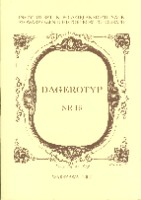
We kindly inform you that, as long as the subject affiliation of our 300.000+ articles is in progress, you might get unsufficient or no results on your third level or second level search. In this case, please broaden your search criteria.






A brief information on the two daguerreotype portraits, found in archive in Cieszyn. Digitalized and reedited material.
More...
Article about polish reportage and sports photographer Jan Ryś (1889-?). Digitalized and reedited material.
More...
Information on Polish and Lithuanian publications concerning photography 1995-1996. Digitalized and reedited material.
More...
Article on photography in Piotrków Trybunalski from its begins till 1939 with full list of historical ateliers. Digitalized and reedited material.
More...
The article deals with questions concerning the role and use of photography in the artistic work of the Cracow painter and draftsman Saturnin Świerzyński (1820-1882), as well as the use of his work for the purposes of documentation and advertising. On the basis of the artist’s notes, kept in the National Library in Warsaw (Pamiętnik mojego życia, sygn. akc 12 776; Spis Obrazów przeze mnie malowanych jako też dochodów i wydatków malarskich i rysunkowych tudzież dochodów z lekcyi przeze mnie udzielanych, sygn. akc 12 777, ill. 1) it was possible to provide a series of examples of the use of daguerreotypes, panotypes and photographs by S. Świerzyński in the making of portraits, in the years 1848-1884. Mentioned also were the commissions for colouring photographs accepted by him during the crisis at the time of the outbreak of the January Uprising against Russian rule in July 1863. Still unsolved, however, is the question of Świerzyński’s use of photographs as material in painting vedutas and the interiors of Cracow churches, the principal source of the artist’s renown. On the basis of the Register of Paintings, examples of the carrying out of the photographic documentation of Saturnin Świerzyński’s paintings were provided, carried out on his request between 1876 and 1883, amongst other places (or perhaps exclusively?) in the Cracow atelier of Awit Szubert on 7 Krupnicza Street (previously 17). As a result of the query carried out in Cracow museums two photographs were also discovered („The Interior of the Norbertine nuns church in Cracow”, 1877, The Historical Museum of the City of Cracow, Inventory Number s 8350/IX, ill. 16; „Game in the ruins of Tenczyn Castle”, 1877, The Historical Museum of the City of Cracow, Inventory Numbers 8351/IX, ill. 15.) In the appendix of the article, containing largely excerpts from the manuscripts of the Register of Paintings..., materials have been put together enabling the identification of the remaining, hitherto unknown photographs of the paintings of Saturnin Świerzyński.
More...


Book review: Dawna fotografia lwowska 1839-1939 (Vintage Lvov Photography 1839-1939), Lviv 2004. No English summary available.
More...
W.J. Hiksa (1859-1934; ill. 5, 13), one of the most distinguished amateur photographers in Lithuania in the nineteenth century, was an administrative worker in Werki, the estate of the prince Peter Sayn-Wittgenstein, and subsequently Maria née Wittgenstein and Chlodwig Hohenlohe-Schillingsfürst. His level of educational attainment is unknown, nor are his initial professional duties. During the time of Peter Sayn-Wittgenstein his activities included accompanying the prince on his many travels and taking photographs. He arranged a photographic laboratory in the grounds of the estate, in the home of the park warden (ill. 7-8). The photographic portraits made there he sometimes signed with the stamp Atelier de Werki|J.Hiksa. Hiksa started taking photographs at the age of seventeen, perhaps earlier. His oldest, best-known photographs come from 1876 and were taken in France (ill. 11). The main theme of Hiksa’s work is the everyday life of the aristocracy, in particular his employers, the Sayn-Wittgensteins (ill. 6), their relatives, servants (ill. 8), views of Werki and the surrounding area as well as views of places visited during foreign travels. He left three photo albums (484 photographs in total, the Lithuanian National Museum in Vilnius), many photographs in the collections of the Sayn-Wittgenstein and Hohenlohe-Schilingsfürst families, as well as in the collection of Gerhard Seinbold, in Germany (published in his Die Radziwille Masse..., Gerabronn und Crailsheim 1988, however, without revealing the author), as well as the diary „Reisen des Johann Hiksa in den Jahren 1868 [...] 1906” (manuscript, Lithuanian National Museum). The period of intensive photographing by Hiksa (up to 1887, the death of Peter Sayn-Wittgenstein) coincides with the beginning of impressionism in art. On the basis of entries into his diary, one can presume that he saw the fifth (1880), seventh (1882) and eighth (1886) exhibition of the impressionists, as he was in Paris at the time. The influence of the paintings Hiksa saw is noticeable in photographs such as „Girl in the sun” (ill. 12; see C. Monet, „The Artist’s Garden at Argenteuil”, 1873), as well as the series „In the Werki park” (ill. 10; see E. Manet, „The Monet Family in their Garden”, 1874.) Hiksa’s photographs are characterised by a large degree of individualism, unconventional composition, creative and bold approach. Hiksa’s oeuvre is not fully discovered, documented and researched. He remains a little-known photographer, despite three exhibitions (Vilnius – 2001, Gdańsk – 2003) and publications by the author of this article, M. Matulytė, Photography of Vilnius, 1858-1915, Vilnius 2001, pp. 39-41, 462-463.
More...
This article is concerned with a photograph of the Piwna Street in Warsaw with the characteristic bird sellers’ cages exposed outside the houses (ill. 1). The author of this article had previously attributed this photograph to Karol Beyer (D. Jackiewicz, Sztuka fotografii. Portret, pejzaż, reportaż w fotografii polskiej XIX wieku. Katalog wystawy, Warszawa 1990, cat. no. 127), and this attribution became accepted in the subject literature (W. Mossakowska, Początki fotografii w Warszawie (1839-1863), Warszawa 1994, vol. I, pp. 80, 109). The photograph was reproduced using the woodcut technique in the illustrated weekly Kłosy on the 26th July 1865 (ill. 2). The accompanying caption informed that the trade in birds had just been moved from Zapiecek Street to Piwna Street. Together, this allowed the dating of the photograph to July 1865 at the latest. Still, however, nothing was known about its author. Another copy of this photograph has recently been discovered in the archives of the National Museum in Warsaw. Below the photograph, on a cardboard background is a printed text: „Fotogra: Jan Mieczkowski | w Warszawie.” (ill. 3). In this way it became known that the authorship is other than what had previously been thought. This can also be applied to the photograph „Market on the Old Town Square” (ill. 4), also previously attributed to Beyer (Jackiewicz, Ibid., cat. no. 128; Mossakowska, Ibid., vol. I, pp. 80-81, vol. II, ill. 73). Its „painterly retouch”, similar to that on the photograph of Piwna Street, allows us to suspect that we are also dealing here with the work of the Warsaw photographer Jan Mieczkowski. On the basis of this example, the author analysed the problems of attributing unsigned photographs, especially early photographs from the third quarter of the nineteenth century. If one does not have access to other copies of the same photograph with the photographer’s signature provided (handwritten signature, facsimile of the signature, an ink or dry stamp of the photograph laboratory, the laboratory’s company overprint on the front or back of the cardboard background), neither access to its reproduction in a periodical giving the name of the author, nor to an archival record, a series of considerations should be taken into account, and conclusions should be reached on the basis of the technical analysis of the object in question. The following are significant: the method of composing and operating light, the shade of the copy and its retouching, fragments of the photographic atelier which may be visible on the photograph, the themes dealt with by the photographer according to which one might presume that he could be author of the photograph. Knowledge about the collector from whose collection the photograph comes could also be helpful, amongst other things concerning his preferences and contacts in the photographic community, and also concerning his travels and the history of his collection.
More...
During the Second World War propaganda activity was carried out on behalf of the Allied Nations, with exhibitions of contemporary art and photography being organised. Polish painters and sculptors – soldiers and refugees – regularly took part in the annual salons of the English and Scottish artistic societies; noted also was the significant involvement of Poles in group shows: „Exhibition of Works by Allied Artists” (National Gallery of Scotland, Edinburgh 1941, Suffolk Street Galleries, London, 1942), the exhibition of artists from the allied armies, National Portrait Gallery, London 1942, military exhibition, National Gallery, London 1942, exhibition of a dozen allied countries, Durland Hall, London 1942 (photographs portraying the „Polish war effort” were also displayed here.) From 1940, travelling exhibitions on the theme of „knowledge of Poland for Foreigners” were organised, using photographs, amongst other mediums; in 1941 photographs of the Narvik campaign were shown in Scotland, in 1942 in Harrods in London – the exhibition „The Polish woman in the service of Poland” was shown, in 1944 in Oxford – an exhibition presenting the „historical and political development of Poland”. A general exhibition, „Poland” was on show at the Suffolk Street Galleries in London from March 1943; it had previously been shown in Edinburgh (from the 25th September 1942), and in Glasgow. From the 6th to the 28th March 1942 in the National Gallery of Scotland, ran an exhibition of Polish artistic and amateur photography, „Through Polish Eyes”. The exhibition, the brainchild of P. Miller, was curated by a watercolour painter active before the war in Paris, Captain Oktawian Jastrzembski, and was organised by the Polish military command, the Edinburgh Photographic Society and The British Council. Around 400 photographs were shown from around 9,000 submitted; almost one-third depicted „our journey from Poland to Great Britain”, as well as „a day in the life of Polish soldier on the British Isles”. In May 1942, the Grundy Art Gallery in Blackpool opened another exhibition of Polish photography, made up in two parts from „Through Polish Eyes” and „Poland Yesterday and Today”. These initiatives of the Polish military were preceded by a further important photographic presentation prepared in England just half a year later: the „Battle for Freedom” exhibition, at London’s Royal Academy of Arts during September 1942. Attempts at displaying our country to the British, its history, culture, art and landscape, did not limit themselves to the organisation of exhibitions. This role was also to be carried out by wall calendars and photographic albums accompanied by appropriate commentaries, published in London by Lewitt-Him (Jan Lewitt and Jerzy Him, both working in London from 1937 and known there as John Le Witt and George Him), a graphics company active in Warsaw before the war.
More...

Full title: Photographs without ambition. Explanations on the margin of the article of Anna Żakiewicz “In the third place a photographer; in other words, how to interpret the photographic creativity of Stanisław Ignacy Witkiewicz” (Fotografie pozbawione ambicji. Wyjaśnienia na marginesie artykułu Anny Żakiewicz Po trzecie – fotograf, czyli jak interpretować twórczość fotograficzną Stanisława Ignacego Witkiewicza). - see Dagerotyp 11:2002, p. 11-17.
More...
Photographic exhibitions in Poland in 2004.
More...
The Photos of Walter Zadek Made in Palestina Between 1935 and 1941
More...